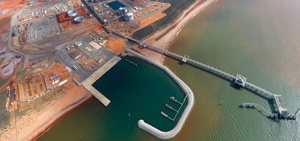Chevron Wheatstone LNG cost blowout to $34 B hits Woodside
(Reuters) Woodside Petroleum said Monday it faces an 8% rise in its expected costs on the Wheatstone LNG project in Australia, after operator Chevron Corp. flagged total costs would jump to $34 B.
Chevron said last Friday delays in module deliveries to the Wheatstone project had resulted in a $5 B blowout in costs from its estimate in 2011. It still expects the plant, which will have two production units, to start output in mid-2017.
Woodside bought a 13% stake in the project last year, but said its exposure to the cost increase is less than that as it made its own estimates when it joined the project and has a different position in the gas production side of it.
"It is within the range of outcomes expected at the time of the acquisition of Apache's interest in the Wheatstone Joint Venture and can be funded by existing cash and undrawn debt facilities," Woodside said in a statement to the Australian stock exchange.
Chevron blamed the delay in module deliveries to Wheatstone mainly on "poor performance" at one of the fabricating yards it originally chose, which led it to redirect work to other yards.
The cost jump comes on top of a $17 B blowout Chevron suffered on the bigger Gorgon LNG project off Australia's west coast, where two out of three production units, are now up and running.
Chevron Chief Financial Officer Patricia Yarrington conceded that the increases on both projects had partly been due to the company's own "underestimation of the quantity of materials that were required."
"It is one of the primary areas we are trying to improve our project execution going forward," Yarrington told analysts on the company's quarterly conference call on Friday.
Chevron said production at train 1 at Gorgon has been stable at about 5 MMtpy, and with train 2 ramping up, it expects to ship an average of two to three cargoes a week. Train 3 is expected to start producing in 2Q of 2017.
Reporting by Sonali Paul; Editing by Alan Crosby







Comments